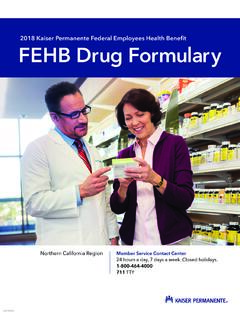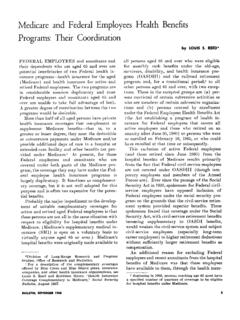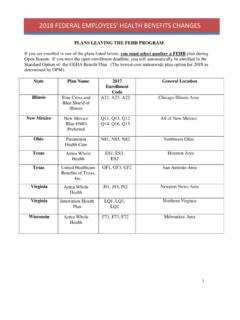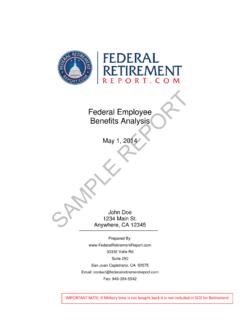Transcription of FEDERAL EMPLOYEES EALTH BENEFITS PROGRAM - narfe.org
1 For more information, please contact the advocacy department at FEDERAL EMPLOYEES health BENEFITS PROGRAM The FEDERAL EMPLOYEES health BENEFITS PROGRAM (FEHBP), created by the FEDERAL EMPLOYEES health BENEFITS Act of 1959 ( 86-382), has been in existence for more than 50 years. Since its inception, FEHBP has provided private health insurance coverage to FEDERAL EMPLOYEES , annuitants and their dependents. Covering about 8 million enrollees, it is the largest employer-sponsored health insurance PROGRAM in the nation. Basic Structure1 The general model of FEHBP has not changed since it was created.
2 Its central mechanism is to provide enrollees choice among competing health plans offered by private insurers within broad FEDERAL guidelines established by statute and the Office of Personnel Management (OPM). The FEDERAL government and the employee or annuitant always have shared the cost of the premium. Currently, costs are shared pursuant to the Fair Share formula, explained below. FEHBP participation is voluntary. Enrollees can elect coverage in an approved plan for either Self Only, Self Plus One, or Self and Family coverage. FEHBP offers enrollees choices among nationally available fee-for-service plans and locally available plans.
3 Many plans in FEHBP offer a standard option, a high option, and/or a high-deductible plan. The number of plans available to an enrollee varies according to where the enrollee resides, but most enrollees typically can choose from among six to 15 different plans. Premiums and cost-sharing requirements vary according to the plan, although the government s employee contribution to premiums has limited variance. Fair Share Formula The government s employer contribution for participants health insurance premiums is determined by the Fair Share formula, which results in the government providing a contribution equal to 72 percent of the weighted average of all plan premiums, and capping the government contribution at 75 percent of any plan s total premium.
4 This formula was intended to maintain a consistent level of government contributions, as a percentage of total PROGRAM costs, regardless of which health plan an enrollee elects. Under the Fair Share formula, in any given year, EMPLOYEES must pay more for higher cost plans, in both actual dollars and as a percentage of the premiums. In so doing, the formula ensures that EMPLOYEES the insurance consumers bear the entire additional (or marginal) cost of plans whose costs exceed the average. This arrangement enlists consumer choice and mobility in keeping premiums down.
5 At the same time, the Fair Share formula ensures that the government contribution increases as the cost of medical care increases, and prevents EMPLOYEES purchasing an average cost plan from bearing a continually higher share of premiums. In the private market, higher cost plans have more comprehensive coverage and better provider access than lower cost options. As a result, individuals with greater health care needs tend to remain in higher cost plans, while healthier individuals tend to choose lower cost options. As higher cost options lose healthier enrollees and keep less healthy ones, higher claims for these plans cause premiums to rise.
6 Over time, carriers have withdrawn some high option plans when premiums became too expensive. Such a system can precipitate a race to the bottom, or what economists call 1 See Mach, Annie L. & Cornell, Ada S., Laws Affecting the FEDERAL EMPLOYEES health BENEFITS PROGRAM , Congressional Research Service, February 13, 2013. adverse selection, in which workers and annuitants are limited to plans with less coverage and smaller provider networks. However, the Fair Share formula s 75 percent cap on the government contribution toward any premium provides an important check against this race to the bottom.
7 Historical Data on Premiums FEHBP premiums rose, on average, by percent in 2017, percent in 2016, percent in 2015, percent in 2014, percent in 2013, percent in 2012 and percent in 2011. Since 1999, when the Fair Share formula was instituted, premiums have increased an average of percent per year. Over just the past 10 years, the average increase has been These numbers track closely with private-sector health insurance premium Model PROGRAM FEHBP is widely considered a model health insurance PROGRAM by health insurance experts and members of Congress from both parties.
8 By ensuring consumer choices and promoting competition while providing adequate premium support and maintaining protections against diminishing coverage, the PROGRAM is able to keep prices down for enrollees, their dependents and taxpayers while providing quality health care coverage. Its framework of competing private insurers has been the model for both the Romney/Ryan proposal for Medicare reform as well as the state-based exchanges created pursuant to the Affordable Care Act. In fact, every major Medicare reform proposal over the last 20 years has been based on the FEHBP model.
9 FEDERAL EMPLOYEES Dental and Vision Insurance PROGRAM (FEDVIP) Pursuant to the FEDERAL employee Dental and Vision BENEFITS Enhancement Act of 2004, OPM makes available dental and vision plans to FEDERAL and postal EMPLOYEES and annuitants, and eligible family members. Enrollees pay for the full cost of coverage, but premiums are deducted from the salary of FEDERAL and postal EMPLOYEES on a pretax basis. Also, because the PROGRAM is available on a group basis, enrollees are afforded competitive premiums, and have no preexisting condition limitations for enrollment.
10 Self Only, Self Plus One, and Self and Family options are available. 2 Data on FEHBP premiums provided by the Office of Personnel Management. 3 Compare Kaiser Family Foundation, 2016 Employer health BENEFITS Survey, Exhibit , available at: (showing premium increases for employer-sponsored plans for single and family coverage).














